
A Galactic lens is a component of a galaxy. It presents an almost uniform distribution of surface brightness. [1]

A Galactic lens is a component of a galaxy. It presents an almost uniform distribution of surface brightness. [1]
This aspect can be noticeable in the region between the bulge and the disk. The bulge is a tightly packed groups of stars within a larger formation, and a disk is a component of disk galaxies consisting of gas and stars. Most likely, these structures arise from the "blurring" of the bars. [1]
The lens in the structure of galaxies is an elliptical-shaped component with a nearly uniform distribution of surface brightness and sharp boundaries, whose contribution can be seen in the region between the bulge and the disk, and sometimes in other regions as well. [1] [2]
The lenses are triaxial ellipsoids: in the direction perpendicular to the galactic plane, they are flattened, but not as much as disks, and in the projection on the disk plane, the ratio of major and minor axes is on average 0.9. [3]
Lenses are closely connected with bars and are often found in galaxies with bars - in 54% of SB0-SBa galaxies and in 76% of SBab-SBc galaxies. In those cases when a galaxy contains both a bar and a lens, their sizes most often coincide. [1]
Lenses most likely arise from bars, although some types of lens cannot be explained by this. Two mechanisms are known that can lead to lens formation. Over time the bar may become more axisymmetric. Not necessarily immediately is all the bar's matter redistributed in this way, as observed galaxies often have both a bar and a lens. The second is that lenses, like bars, arise in the presence of bar-forming instability. [4]
Lenses have been known since at least 1959, first discovered by Gérard de Vaucouleurs, in which he proposed a scheme for classifying galaxies. [5]

Spiral galaxies form a class of galaxy originally described by Edwin Hubble in his 1936 work The Realm of the Nebulae and, as such, form part of the Hubble sequence. Most spiral galaxies consist of a flat, rotating disk containing stars, gas and dust, and a central concentration of stars known as the bulge. These are often surrounded by a much fainter halo of stars, many of which reside in globular clusters.

A lenticular galaxy is a type of galaxy intermediate between an elliptical and a spiral galaxy in galaxy morphological classification schemes. It contains a large-scale disc but does not have large-scale spiral arms. Lenticular galaxies are disc galaxies that have used up or lost most of their interstellar matter and therefore have very little ongoing star formation. They may, however, retain significant dust in their disks. As a result, they consist mainly of aging stars. Despite the morphological differences, lenticular and elliptical galaxies share common properties like spectral features and scaling relations. Both can be considered early-type galaxies that are passively evolving, at least in the local part of the Universe. Connecting the E galaxies with the S0 galaxies are the ES galaxies with intermediate-scale discs.

In astronomy, a galactic bulge is a tightly packed group of stars within a larger star formation. The term almost exclusively refers to the central group of stars found in most spiral galaxies. Bulges were historically thought to be elliptical galaxies that happened to have a disk of stars around them, but high-resolution images using the Hubble Space Telescope have revealed that many bulges lie at the heart of a spiral galaxy. It is now thought that there are at least two types of bulges: bulges that are like ellipticals and bulges that are like spiral galaxies.

Galaxy morphological classification is a system used by astronomers to divide galaxies into groups based on their visual appearance. There are several schemes in use by which galaxies can be classified according to their morphologies, the most famous being the Hubble sequence, devised by Edwin Hubble and later expanded by Gérard de Vaucouleurs and Allan Sandage. However, galaxy classification and morphology are now largely done using computational methods and physical morphology.
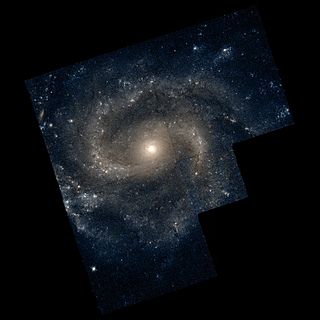
NGC 1042 is a spiral galaxy located in the constellation Cetus. It was discovered on 10 November 1885 by American astronomer Lewis Swift. The galaxy has an apparent magnitude of 14.0.

NGC 1553 is a prototypical lenticular galaxy in the constellation Dorado. It is the second brightest member of the Dorado Group of galaxies. British astronomer John Herschel discovered NGC 1553 on December 5, 1834 using an 18.7 inch reflector.

NGC 4762 is an edge-on lenticular galaxy in the constellation Virgo. It is at a distance of 60 million light years and is a member of the Virgo Cluster. The edge-on view of this particular galaxy, originally considered to be a barred spiral galaxy, makes it difficult to determine its true shape, but it is considered that the galaxy consists of four main components — a central bulge, a bar, a thick disc and an outer ring. The galaxy's disc is asymmetric and warped, which could be explained by NGC 4762 merging with a smaller galaxy in the past. The remains of this former companion may then have settled within NGC 4762's disc, redistributing the gas and stars and so changing the disc's morphology.

NGC 7007 is a lenticular galaxy with a small bar, around 100 million light-years away from Earth in the constellation Indus. It was discovered by astronomer John Herschel on July 8, 1834. The galaxy is a type 2 seyfert galaxy, and is host to a supermassive black hole with an estimated mass of 4.9 × 107M☉.
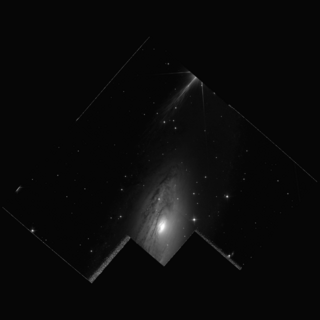
NGC 7013 is a relatively nearby spiral or lenticular galaxy estimated to be around 37 to 41.4 million light-years away from Earth in the constellation of Cygnus. NGC 7013 was discovered by English astronomer William Herschel on July 17, 1784 and was also observed by his son, astronomer John Herschel on September 15, 1828.

NGC 7020 is a barred lenticular galaxy located about 140 million light-years away in the constellation Pavo. NGC 7020 was discovered by astronomer John Herschel on August 31, 1836.

UGC 6614 is a giant spiral galaxy located about 330 million light-years away in the constellation Leo. It has an estimated diameter of nearly 300,000 light-years.
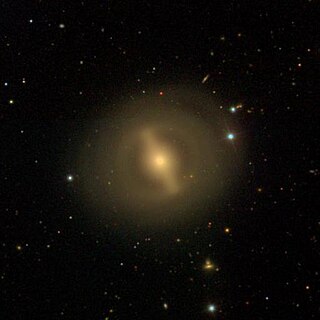
NGC 4608 is a barred lenticular galaxy located in the constellation of Virgo. The galaxy was discovered by astronomer William Herschel on March 15, 1784. At about 56 million light-years away, it is a member of the Virgo Cluster.
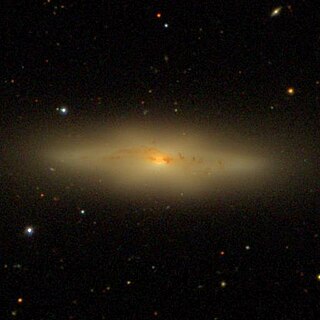
NGC 4469 is a nearly edge-on spiral galaxy located about 55 million light-years away in the constellation of Virgo. It is also classified as a LINER galaxy. NGC 4469 was discovered by astronomer William Herschel on April 15, 1784. It is a member of the Virgo Cluster.
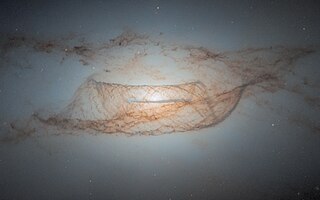
NGC 4753 is a lenticular galaxy located about 60 million light-years away in the constellation of Virgo. NGC 4753 was discovered by astronomer William Herschel on February 22, 1784. It is notable for having distinct dust lanes that surround its nucleus. It is a member of the NGC 4753 Group of galaxies, which is a member of the Virgo II Groups, a series of galaxies and galaxy clusters strung out from the southern edge of the Virgo Supercluster.
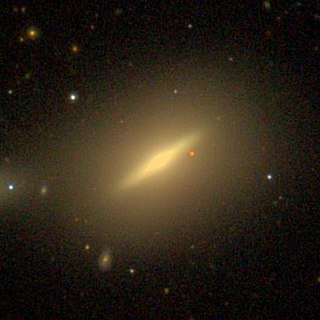
NGC 4638 is an edge-on lenticular galaxy located about 50 million light-years away in the constellation Virgo. NGC 4638 was discovered by astronomer William Herschel on March 15, 1784. The galaxy is a member of the Virgo Cluster.

NGC 4299 is a featureless spiral galaxy located about 55 million light-years away in the constellation Virgo. It was discovered by astronomer William Herschel on March 15, 1784 and is a member of the Virgo Cluster.

NGC 4513 is a lenticular galaxy and a ring galaxy located about 110 million light-years away in the constellation Draco. It was discovered by astronomer Heinrich d'Arrest on October 16, 1866.

NGC 4800 is an isolated spiral galaxy in the constellation Canes Venatici, located at a distance of 95 megalight-years from the Milky Way. It was discovered by William Herschel on April 1, 1788. The morphological classification of this galaxy is SA(rs)b, indicating a spiral galaxy with no visual bar at the nucleus (SA), an incomplete ring structure (rs), and moderately-tightly wound spiral arms (b). The galactic plane is inclined to the line of sight by an angle of 43°, and the long axis is oriented along a position angle of 25°. There is a weak bar structure at the nucleus that is visible in the infrared.

NGC 4393 is a spiral galaxy about 46 million light-years away in the constellation Coma Berenices. It was discovered by astronomer William Herschel on April 11, 1785. It is a member of the NGC 4274 Group, which is part of the Coma I Group or Cloud.

UGC 711 is a relatively nearby spiral galaxy located in the constellation of Cetus. Estimated to be located 77 million light-years from Earth, the galaxy's luminosity class is IV and it has a HI line width region. It belongs to the equatorial region of Eridanus Void with an arcsec approximation of ≈ 250.